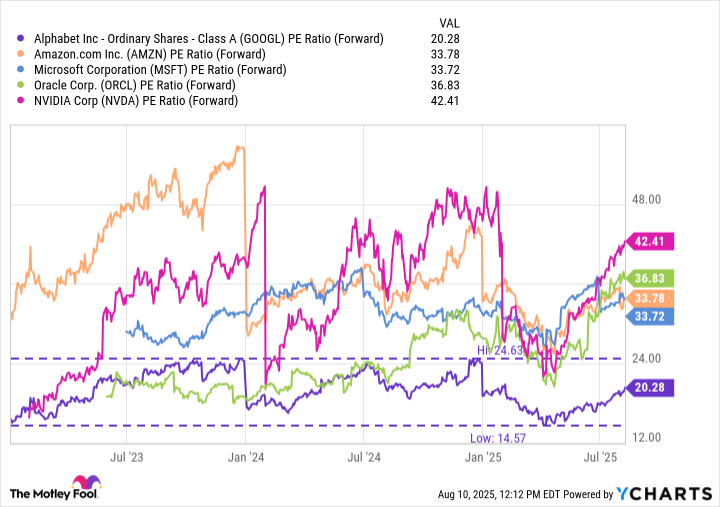AI Research
This Artificial Intelligence (AI) Stock Could Be the Nvidia of Quantum Computing

While IonQ, Rigetti Computing, and D-Wave Quantum are central figures in the quantum computing spotlight, I see a member of the “Magnificent Seven” as the superior choice.
Back in 1999, a fledgling semiconductor company called Nvidia invented a chipset called the graphics processing unit (GPU) — a product that, at the time, few people realized they would one day need.
Two decades ago, GPUs were primarily marketed toward gamers and graphic designers. But Nvidia’s visionary CEO, Jensen Huang, saw the broad potential of these advanced chips before anyone else.
When the GPU was initially released, AI applications were both niche and barely imagined. But Huang understood that the world’s most important problems would be solved by anticipating latent needs — capabilities that people will demand at some point in the future, even if they can’t fully describe them today.
Huang realized that GPUs could be parlayed for more sophisticated problem solving that traditional CPUs at the time could not handle efficiently, ultimately becoming the foundational layer on which artificial intelligence (AI) modeling, research, and data analytics are built.
In a similar fashion, internet and cloud computing juggernaut Alphabet (GOOG 1.25%) (GOOGL 1.14%) has been quietly pushing the envelope in a new pocket of the AI realm that’s gaining attention: quantum computing.
Let’s dive into Alphabet’s innovative approach to developing quantum applications and explore how the company’s progress parallels that of Nvidia’s pioneering role in AI before it went mainstream.
How is Alphabet building quantum computing applications?
Back in December, Alphabet unveiled its latest breakthrough in the quantum computing arms race: a processor called Willow. With 105 qubits and enhanced algorithmic features across error correction, Willow might appear as just another incremental improvement over prior generations of quantum chips released by Alphabet and its peers.
Where Willow caught the attention of AI enthusiasts was through an experiment in Random Circuit Sampling (RCS), in which its quantum processing was measured against classical supercomputers. In this study, Alphabet claims that Willow solved a sophisticated series of computations in under 5 minutes that would take today’s most capable supercomputers an estimated 10 septillion years to complete.
Image source: Getty Images.
Why Alphabet is to quantum computing what Nvidia is to AI
While Alphabet’s quantum supremacy may not have ample commercial uses today, the idea here is that the company’s innovations and technological breakthroughs are similar to that of Nvidia and the invention of the GPU back in the late 1990s. Willow and the GPU both represent underlying proof that Alphabet and Nvidia have been at the forefront of innovations where conventional approaches are not able to compete at scale.
Similar to Nvidia, Alphabet is not building its AI business through a singular lens. Under its umbrella, Alphabet has TensorFlow — an open-source machine learning platform. In addition, Alphabet’s Google Quantum AI team operates an open-source software framework called Cirq, which helps Python developers research and build applications. Lastly, Google DeepMind serves as a research lab spanning various aspects of the AI spectrum, including quantum computing.
To me, the formation of Alphabet’s AI ecosystem aligns closely with Nvidia’s approach. Outside of its hardware specialty, Nvidia also offers software through its CUDA infrastructure. This decision ultimately created a virtuous cycle in which developers building generative AI applications continually demand additional GPU and software capacity — leading to a self-reinforcing technological moat for Nvidia.
I think Alphabet is employing a similar strategy, betting that classical computing will eventually become exhausted by increasingly sophisticated AI workloads. When this occurs, Alphabet will have already architected the leap from classical to quantum computing.
Just as Nvidia has done throughout the AI revolution thanks to its GPUs and software platform, Alphabet could one day be positioned as the main ecosystem on which quantum applications are developed.
Is Alphabet stock a buy right now?
Throughout the AI revolution, many of Alphabet’s peers have experienced notable expansion in their valuation multiples.
GOOGL PE Ratio (Forward) data by YCharts
At the moment, however, Alphabet is trading roughly in line with its three-year average forward price to earnings (P/E) ratio. Not only is the valuation discount to its peers striking, but I think it’s overstated.
Over the last three years, Alphabet has continued to innovate across several areas of AI, including new capabilities in search, video, e-commerce, cybersecurity, and of course, hardware such as quantum chips. Nevertheless, the upside from these investments do not appear to be fully priced into the company’s long-term financial success.
Just as Nvidia has proven to be one of the most lucrative long-term buys of the decade, I see Alphabet positioned to follow a prolonged breakout period featuring notable valuation expansion as its AI-powered products continue to scale and become a more central part of the company’s growth narrative. For these reasons, I think that Alphabet stock is dirt cheap and looks like a compelling opportunity at its current price level.
Adam Spatacco has positions in Alphabet, Amazon, Microsoft, and Nvidia. The Motley Fool has positions in and recommends Alphabet, Amazon, Microsoft, Nvidia, and Oracle. The Motley Fool recommends the following options: long January 2026 $395 calls on Microsoft and short January 2026 $405 calls on Microsoft. The Motley Fool has a disclosure policy.
AI Research
Will artificial intelligence fuel moral chaos or positive change?

Artificial intelligence is transforming our world at an unprecedented rate, but what does this mean for Christians, morality and human flourishing?
In this episode of “The Inside Story,” Billy Hallowell sits down with The Christian Post’s Brandon Showalter to unpack the promises and perils of AI.
From positives like Bible translation to fears over what’s to come, they explore how believers can apply a biblical worldview to emerging technology, the dangers of becoming “subjects” of machines, and why keeping Christ at the center is the only true safeguard.
Plus, learn about The Christian Post’s upcoming “AI for Humanity” event at Colorado Christian University and how you can join the conversation in person or via livestream:
“The Inside Story” takes you behind the headlines of the biggest faith, culture and political headlines of the week. In 15 minutes or less, Christian Post staff writers and editors will help you navigate and understand what’s driving each story, the issues at play — and why it all matters.
Listen to more Christian podcasts today on the Edifi app — and be sure to subscribe to The Inside Story on your favorite platforms:
AI Research
BNY and Carnegie Mellon University announce five-year $10 million partnership supporting AI research — EdTech Innovation Hub

The $10 million deal aims to bring students, faculty and staff together alongside BNY experts to advance AI applications and systems to prepare the next generation of leaders.
Known as the BNY AI Lab, the collaboration will focus on technologies and frameworks that can ensure robust governance of mission-critical AI applications.
“As AI drives productivity, unlocks growth and transforms industries, Pittsburgh has cemented its role as a global hub for innovation and talent, reinforcing Pennsylvania’s leadership in shaping the broader AI ecosystem,” comments Robin Vince, CEO at BNY. “Building on BNY’s 150-year legacy in the Commonwealth, we are proud to expand our work with Carnegie Mellon University to help attract world-class talent and pioneer AI research with an impact far beyond the region.”
A dedicated space for the collaboration will be created at the University’s Pittsburgh campus during the 2025-26 academic year.
“AI has emerged as one of the single most important intellectual developments of our time, and it is rapidly expanding into every sector of our economy,” adds Farnam Jahanian, President of Carnegie Mellon. “Carnegie Mellon University is thrilled to collaborate with BNY – a global financial services powerhouse – to responsibly develop and scale emerging AI technologies and democratize their impact for the benefit of industry and society at large.”
The ETIH Innovation Awards 2026
The EdTech Innovation Hub Awards celebrate excellence in global education technology, with a particular focus on workforce development, AI integration, and innovative learning solutions across all stages of education.
Now open for entries, the ETIH Innovation Awards 2026 recognize the companies, platforms, and individuals driving transformation in the sector, from AI-driven assessment tools and personalized learning systems, to upskilling solutions and digital platforms that connect learners with real-world outcomes.
Submissions are open to organizations across the UK, the Americas, and internationally. Entries should highlight measurable impact, whether in K–12 classrooms, higher education institutions, or lifelong learning settings.
Winners will be announced on 14 January 2026 as part of an online showcase featuring expert commentary on emerging trends and standout innovation. All winners and finalists will also be featured in our first print magazine, to be distributed at BETT 2026.
AI Research
Beyond Refusal — Constructive Safety Alignment for Responsible Language Models

View a PDF of the paper titled Oyster-I: Beyond Refusal — Constructive Safety Alignment for Responsible Language Models, by Ranjie Duan and 26 other authors
Abstract:Large language models (LLMs) typically deploy safety mechanisms to prevent harmful content generation. Most current approaches focus narrowly on risks posed by malicious actors, often framing risks as adversarial events and relying on defensive refusals. However, in real-world settings, risks also come from non-malicious users seeking help while under psychological distress (e.g., self-harm intentions). In such cases, the model’s response can strongly influence the user’s next actions. Simple refusals may lead them to repeat, escalate, or move to unsafe platforms, creating worse outcomes. We introduce Constructive Safety Alignment (CSA), a human-centric paradigm that protects against malicious misuse while actively guiding vulnerable users toward safe and helpful results. Implemented in Oyster-I (Oy1), CSA combines game-theoretic anticipation of user reactions, fine-grained risk boundary discovery, and interpretable reasoning control, turning safety into a trust-building process. Oy1 achieves state-of-the-art safety among open models while retaining high general capabilities. On our Constructive Benchmark, it shows strong constructive engagement, close to GPT-5, and unmatched robustness on the Strata-Sword jailbreak dataset, nearing GPT-o1 levels. By shifting from refusal-first to guidance-first safety, CSA redefines the model-user relationship, aiming for systems that are not just safe, but meaningfully helpful. We release Oy1, code, and the benchmark to support responsible, user-centered AI.
Submission history
From: Ranjie Duan [view email]
[v1]
Tue, 2 Sep 2025 03:04:27 UTC (5,745 KB)
[v2]
Thu, 4 Sep 2025 11:54:06 UTC (5,745 KB)
[v3]
Mon, 8 Sep 2025 15:18:35 UTC (5,746 KB)
[v4]
Fri, 12 Sep 2025 04:23:22 UTC (5,747 KB)
-

 Business2 weeks ago
Business2 weeks agoThe Guardian view on Trump and the Fed: independence is no substitute for accountability | Editorial
-
Tools & Platforms1 month ago
Building Trust in Military AI Starts with Opening the Black Box – War on the Rocks
-

 Ethics & Policy2 months ago
Ethics & Policy2 months agoSDAIA Supports Saudi Arabia’s Leadership in Shaping Global AI Ethics, Policy, and Research – وكالة الأنباء السعودية
-

 Events & Conferences4 months ago
Events & Conferences4 months agoJourney to 1000 models: Scaling Instagram’s recommendation system
-

 Jobs & Careers3 months ago
Jobs & Careers3 months agoMumbai-based Perplexity Alternative Has 60k+ Users Without Funding
-

 Podcasts & Talks2 months ago
Podcasts & Talks2 months agoHappy 4th of July! 🎆 Made with Veo 3 in Gemini
-

 Education3 months ago
Education3 months agoVEX Robotics launches AI-powered classroom robotics system
-

 Education2 months ago
Education2 months agoMacron says UK and France have duty to tackle illegal migration ‘with humanity, solidarity and firmness’ – UK politics live | Politics
-

 Podcasts & Talks2 months ago
Podcasts & Talks2 months agoOpenAI 🤝 @teamganassi
-

 Funding & Business3 months ago
Funding & Business3 months agoKayak and Expedia race to build AI travel agents that turn social posts into itineraries


